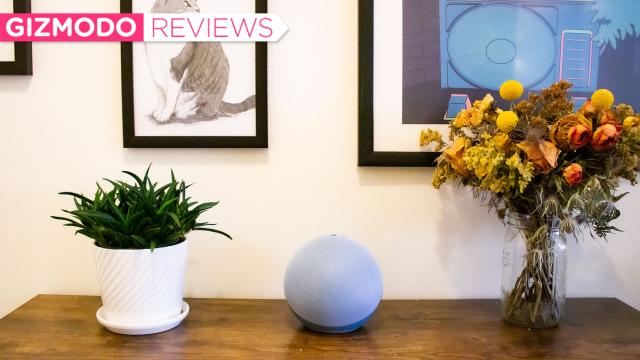It’s round. That’s the story, folks.
In all seriousness, you can’t talk about the fourth-generation Amazon Echo without acknowledging its new globular shape. Visually, it’s a significant departure from the cylindrical Echoes of yore, but it’s more than just Amazon telling you, “Oh, it’s a ball now.” It’s also a way of saying, “This one is different.” And this is true. The fourth-gen Echo is a more notable upgrade from the third-gen Echo, both in terms of forward-looking features and sound quality.
Inside this round boy, you get a 3-inch woofer, as well as dual front-firing 0.8-inch tweeters and support for Dolby audio (though not Dolby Atmos). That’s an additional tweeter from last year’s Echo and the Echo Plus. And like the Echo Studio, the fourth-gen Echo also supports room tuning — as in it’ll fine-tune your audio playback based on the acoustics of your room.
Powering the fourth-gen Echo, you also have Amazon’s AZ1 Neural Edge processor. Amazon says this enables a new “all-neural speech recognition model” that’s supposed to help Alexa process your requests faster. Lastly, you also get support for Zigbee (which was true of last year’s Echo), Bluetooth Low Energy, and Amazon Footpath, Amazon’s low-bandwidth IoT network that’s meant to expand the working range of your smart home gadgets separate from wifi. In a nutshell, Amazon is phasing out the Echo Plus by cramming better audio and smart home hub capability into its mid-range speaker line.
All this is very nice, but Amazon isn’t exactly re-inventing the wheel here. It’s still an Echo. It’s just rounder and for the most part, sounds better.
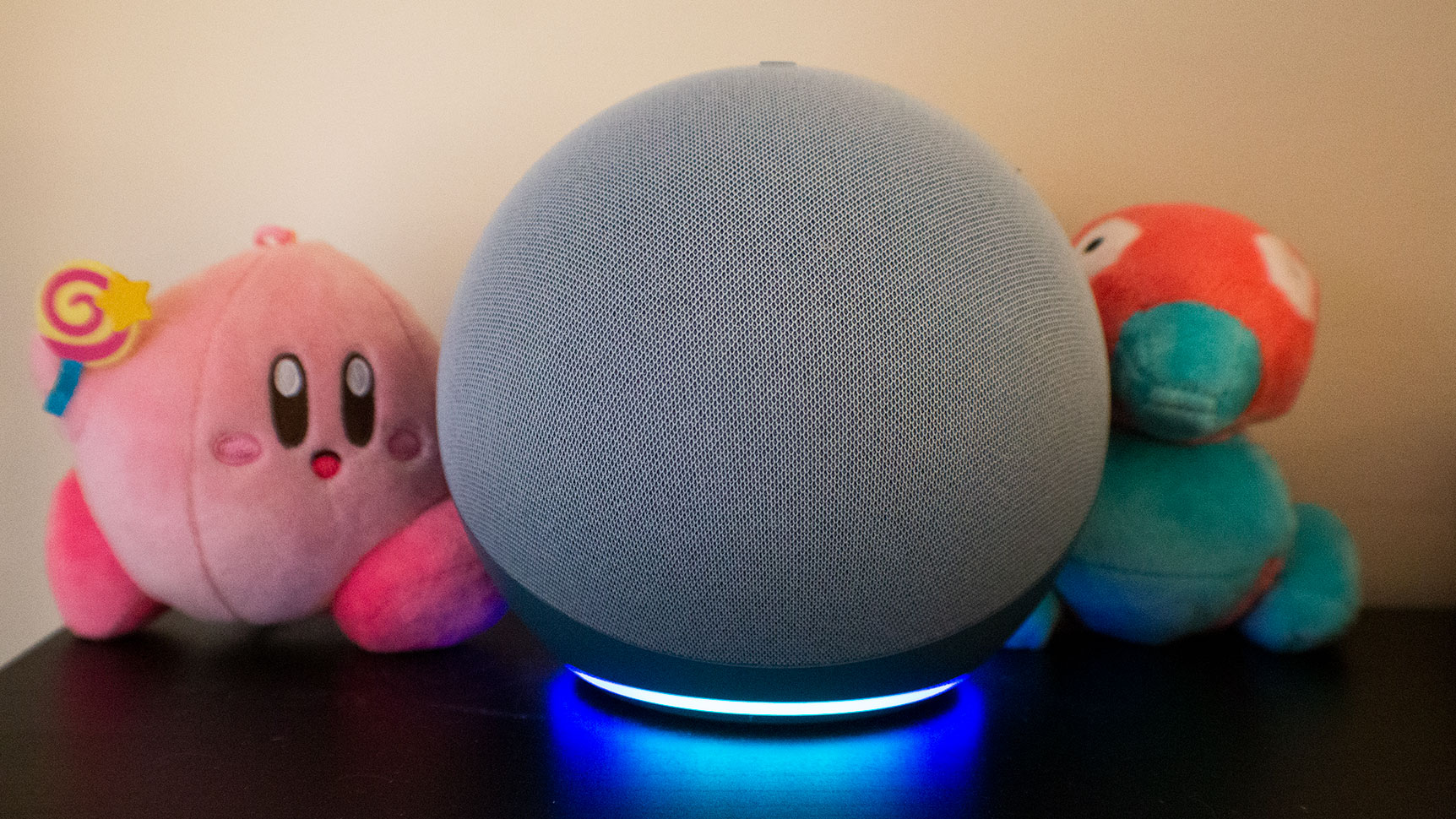
Amazon Echo (4th Generation)
What is it?
The round Echo
Price
$149
Like
It's round. It's also got good bass and improved overall audio quality. Adds built-in Zigbee smart home hub capability.
No Like
Privacy is still a concern. Not truly omnidirectional. Besides audio and design, most upgrades are very incremental.
Design-wise, I appreciate the new Echo. Personally, I find it nicer to look at and it’s easier to blend into my home decor. The top of the Echo is covered in fabric, and you’ll also find buttons to control volume, as well as Alexa and muting the mic. In the back, you’ll find the 3.5mm audio jack if you want to hook it up to an external speaker, and the power cord. Another change is that instead of the Echo’s iconic glow ring being up top, it’s been moved to the base. My review unit came in Twilight Blue, which is quite fetching compared to the usual black Echo colour scheme. Size-wise, it’s 5.7 inches at its widest point and 5.2 inches tall — not too big, about roughly the size of a small planter. At 1 kg, it’s fairly typical for a smart speaker and just slightly lighter than the 1 kg Nest Audio.
For the most part, I like the new design though I have a couple of nitpicks. Firstly, you’re not really getting omnidirectional sound even though the spherical shape might suggest that. The ports are in the back and there’s hard plastic that slopes up on a diagonal meaning, you’re going to have to be very intentional about which direction the Echo is facing. That, plus the need for a wired connection, means this isn’t the best speaker for the middle of an open concept room. That’s not a huge deal per se, but it’s limiting when you consider the attractive new form-factor should open up more possibilities as to where you might stick this thing.
As for sound, I was pleasantly surprised. Amazon’s Echo gadgets have never really impressed me all that much when it comes to sound quality. With the exception of perhaps, the Echo Studio, Echoes were never my go-to listening device unless I happened to be in the kitchen or for gags where I tortured my roommates, and now husband, by playing Luis Fonsi’s seminal classic hit, Despacito feat. Daddy Yankee, followed promptly by Baby Shark and Camilla Cabello’s Havana feat. Young Thug. (Ooh na na).
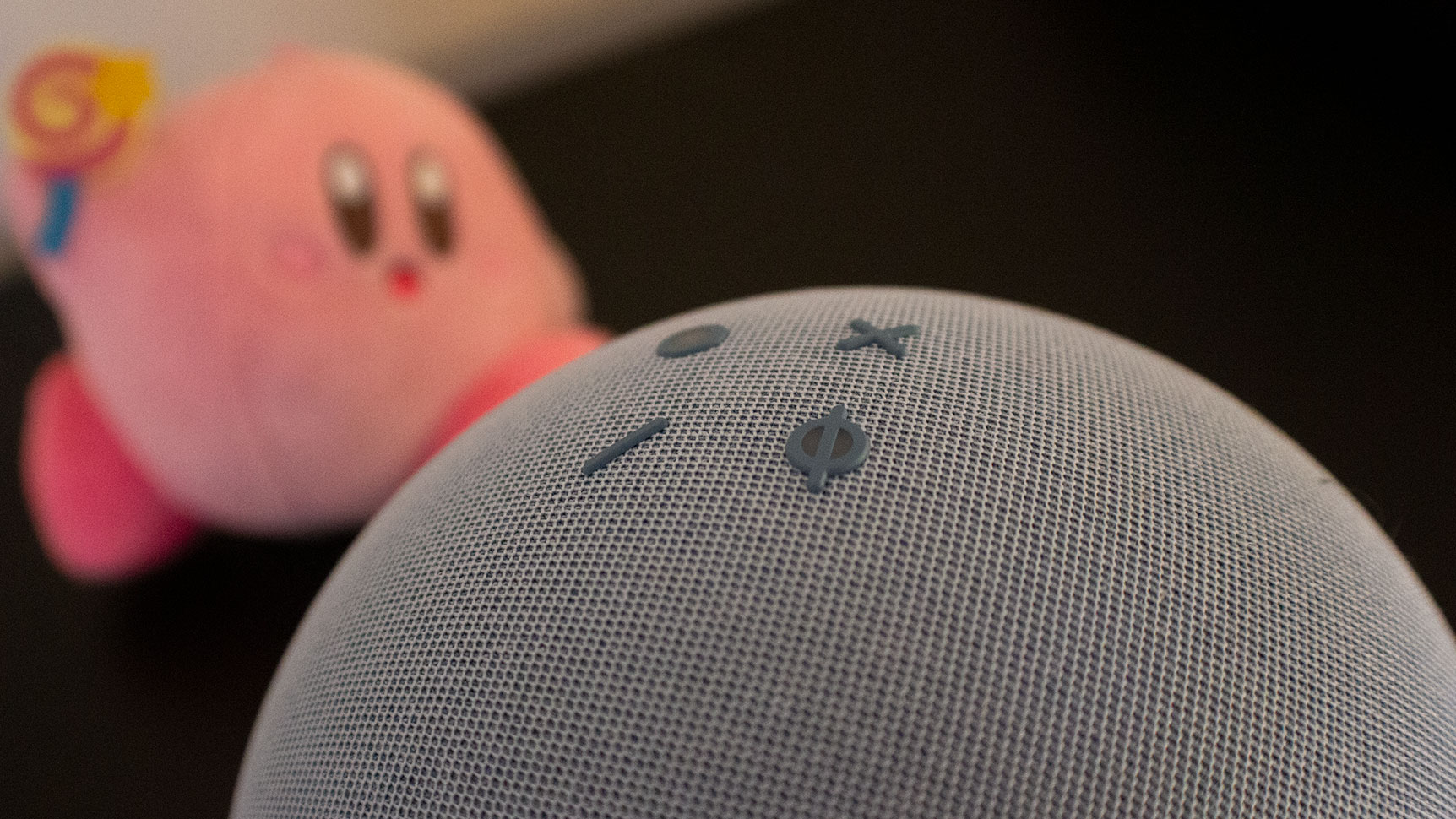
The fourth-generation Echo has a decent soundstage, and for a $149 smart speaker, its bass is actually kind of impressive. It’s not going to out-do my Ultimate Ears Hyperboom, but I’d say it’s a bit more pronounced than the bass on my Sonos Move. On Afterthought by Joji & BENEE, I could feel the bass vibrating my desk, even though the Echo was sitting on the opposite end of an attached bookshelf. I streamed Dragon Ball Z/Super Lofi Mix to the Echo from my phone over Bluetooth and it was a good time.
Treble sounds pretty decent on the Amazon Echo too; the theme from Jurassic Park sounded both majestic and clear. Where I felt the Echo stumbled a bit was in the mids and with the shift between quiet and loud. Mitski’s Your Best American Girl sounded muddled during the chorus when she transitions from a quiet acoustic verse to loud, distorted rock guitars. It’s a transition that speakers sometimes struggle with, and while the Echo didn’t botch it, it sounded notably better on the Sonos Move. I found this was true while listening to Gershwin’s Rhapsody in Blue, another piece of music that shifts between quiet and loud moments. When the trumpets blare, the Echo gets a little muddy. Comparatively, the mix was more well-rounded on the Sonos Move — though you can futz a bit with the Echo’s EQ in the Alexa app if you want to attempt to improve things.
As for room tuning, it’s hard to say whether that made a difference here. You can’t turn it off and the Echo does it automatically, so it’s not something I could really test for. That said, the Echo sounds best when you’re situated right in front of it. I stuck it in the corner of my studio apartment and when I was in the opposite diagonal corner, it didn’t sound nearly as good as when I was in the corner opposite. Likewise, as I mentioned earlier, it’s not a truly omnidirectional speaker. It sounds alright if it’s front is facing away from you, but there’s a notable difference. However, sound quality isn’t the main reason anyone would get a smart speaker. If you wanted that, there are soundbars and plenty of other Bluetooth or wireless speakers you can opt for that also have voice assistants built-in. It just happens to be a nice perk that this one doesn’t suck.
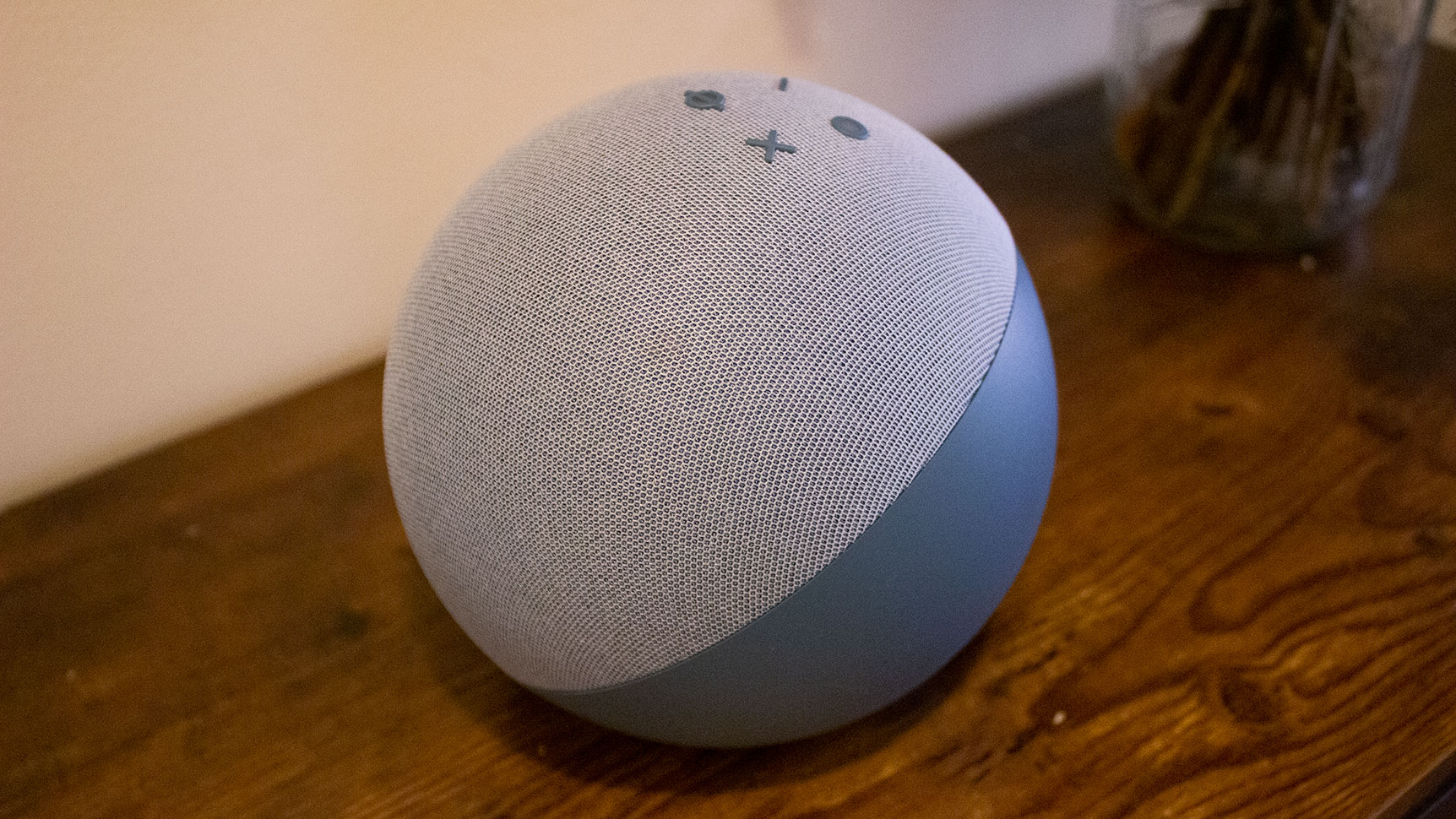
As for smart home control, the Echo hasn’t changed that much. The Alexa app is still, in this blogger’s opinion, annoying to navigate. But it hasn’t gotten worse. Making routines is straightforward, and I find it easier on the Alexa app than on the Google Home app. It also wasn’t hard to set up this Echo or integrate it into my existing smart home setup. Whether you should pick the fourth-generation Echo, the Google Nest Audio, or Apple’s HomePod Mini — all of which are the same price — will come down to your preferred platform.
Siri remains a flaming trash heap of a digital assistant, but Apple has made some strides in making Siri suck marginally less. I don’t know whether it is the AZ1 chip or not, but Alexa was snappy at replying to my queries on the Echo. I routinely got a faster response asking the Echo than asking the Google Assistant on my Nest Home Hub. Though things like turning on and off lights took roughly the same amount of time. Where Google Assistant has an edge, however, is it’s just plain better at understanding natural language and commands — you don’t have to be quite as precise with phrases as you do with Alexa. Also, I had to ask Alexa three times to play Mitski’s Your Best American Girl because apparently, we do not agree on how Mitski is pronounced. I’ve had no such trouble with Google Assistant.
Ultimately, it’ll come down to which smart home products you have in your home. If you’ve got a bunch of Nest gadgets, the Echo is not the best choice, as the Google Nest skill for Alexa is lacking. Conversely, if you’re knee-deep in the Amazon ecosystem and the idea of giving up your Prime account is unthinkable, then I’d recommend this over the Nest Audio.
Needless to say, if privacy is a major concern, you probably shouldn’t get any of these smart speakers and you might want to steer clear of Amazon Echo in particular. Amazon Footpath gives me the heebie-jeebies, especially when it comes to Amazon’s track record with Ring. (For the record, you can opt-out of Amazon Footpath.) Sometime later this year, you’ll be able to tell Alexa to delete everything you’ve ever said, and if you ask your Echo to delete everything you’ve said today, it does walk you through the process. I did this several times, but it did leave me unsettled that whenever I manually reviewed my voice history, I saw plenty of recordings that “were not intended for Alexa.” It bears repeating: If you’re worried about privacy, just don’t get a smart speaker.
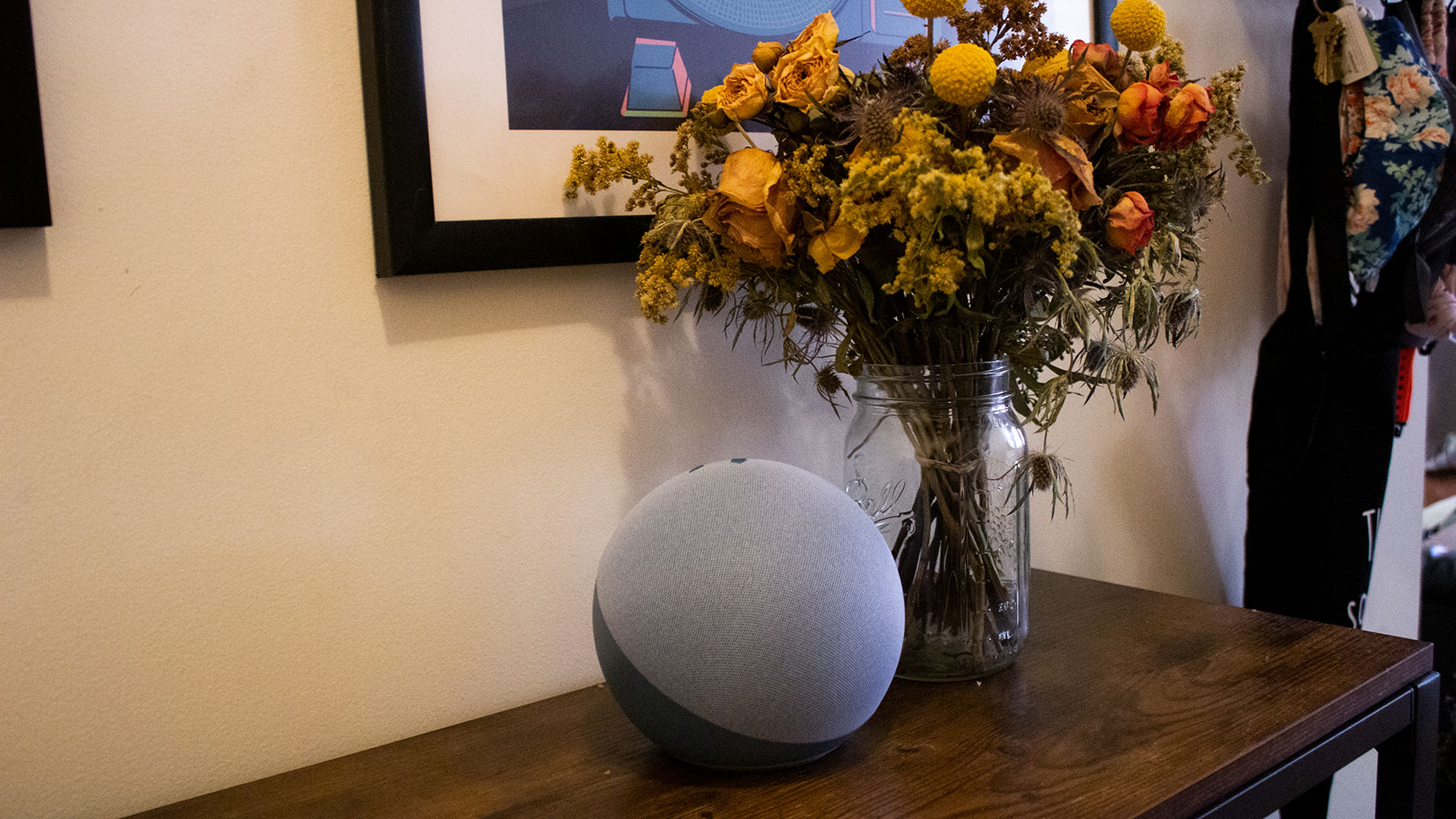
Given the tightening competition in the $149 smart speaker category, the fourth generation Amazon Echo acquits itself well. It’s snazzier looking than the Nest Audio and delivers pretty great sound quality for the price. It’s hard to comment on how its sound quality compares to the similarly round HomePod Mini, as we haven’t gotten our hands on that one just yet. That said, I don’t have to test the Mini to know Alexa is more competent than Siri and that Echoes have had intercom capabilities long before the Mini.
Is it worth upgrading from an older Echo device? Not if you’ve got last year’s Echo or the second-generation Echo Plus. In both instances, you’re only getting an extra 0.8-inch tweeter and in the case of the Plus, you’ve already got the Zigbee smart home hub built-in. Also, if you want 360-degree sound, the third-generation Echo is going to be better for that. But if you’re on an OG Amazon Echo or a second-generation Echo, you could probably do with the boost in audio quality. Other than the improved audio quality and the new round design, many of the upgrades just aren’t that noticeable. At the end of the day, I’m left feeling, like, “Well, this is the round Echo with surprisingly decent audio that does pretty much what my other Echo speakers do.”
Like I said, it’s round. That’s the story.
README
- It’s a ball now!
- Phases out the Echo Plus by giving you the same speakers, plus an extra 0.8-inch tweeter, and Zigbee smart home hub capability.
- Audio quality is much improved (especially bass!) but it’s not truly omnidirectional.
- Adds Amazon’s AZ1 chip for faster Alexa response times, and Amazon Footpath (which you can opt out of.)
